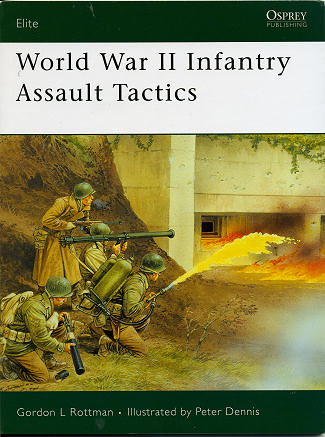 As
was so sagely pointed out in the introduction of this book, all of the machines
and equipment of warfare are designed to eventually allow infantry troops to
reach their objective and in the end, decide the outcome of the conflict.
As
was so sagely pointed out in the introduction of this book, all of the machines
and equipment of warfare are designed to eventually allow infantry troops to
reach their objective and in the end, decide the outcome of the conflict.Osprey's World War II Infantry Assault Tactics
|
Title: |
World War II Infantry Assault Tactics |
|
Author: |
Gordon Rottman, illustrated by Peter Dennis |
|
Publisher/Distributor |
Osprey Publishing |
|
Price |
$18.95 MSRP |
|
Reviewer: |
|
| Notes: |
64 pages, 7¼ x 9¼ inches, softbound ISBN: 978-1-84603-191-5 |
 As
was so sagely pointed out in the introduction of this book, all of the machines
and equipment of warfare are designed to eventually allow infantry troops to
reach their objective and in the end, decide the outcome of the conflict.
As
was so sagely pointed out in the introduction of this book, all of the machines
and equipment of warfare are designed to eventually allow infantry troops to
reach their objective and in the end, decide the outcome of the conflict.
Despite the differences in language and cultural backgrounds, the tactics utilized by the infantry of WWII was pretty much the same in the armies of the major combatants during WWII. This book concentrates on the assault portion of infantry warfare and what that means is being able to overcomes the defenses and obstacles that the other side puts in their way. If the obstacles cannot be overcome or bypassed, then the assault will fail, regardless of the courage and determination of the assaulting troops.
As the war progressed the tools of the trade were either improved or new ones invented. Things like the flame thrower, bazooka/rocket launcher, hand grenade, Bangalore torpedos, and a myriad of other devices were utilized by assaulting troops. Even things as simple as rope ladders and wire cutters are useful.
In his book Gordon Rottman covers the basic infantry units and describes tactics for breaching obstacles; including those that are specific to certain nations. Then there is a goodly section on the various demolition materials used to breach these obstacles. Once again, nation-specific materials are covered. This then goes into the effectiveness of the weapons used by the assaulting troops and the sort of support that they could expect from other units.
This is all finished up with a section on the general practices of the various nations that are unique to them (for instance, the Japanese tendency to always act boldly and decisively even when the situation called for something else, and the tendency for the Soviet Union to use 'steamroller' tactics that threw a mass of men at an objective, hoping to overwhelm it with numbers.
Overall, it is a superb look at how the armed forces of the nations involved in WWII were similar and different. A book that I know you will find interesting and engrossing.
May 2008
For more on the complete line of Osprey books, visit www.ospreypublishing.com. In the US, it is Osprey Direct at 44-02 23rd St, Suite 219, Long Island City, NY 11101., where you can get a catalogue of available books.
If you would like your product reviewed fairly and quickly, please contact me or see other details in the Note to Contributors.